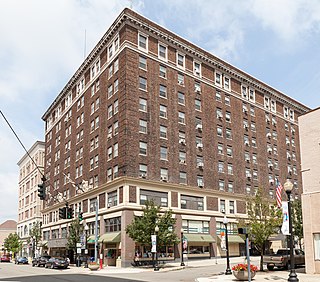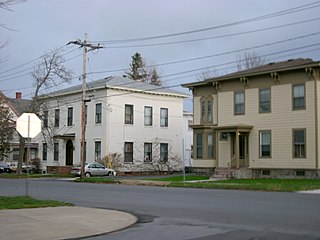
The Central Troy Historic District is an irregularly shaped, 96-acre (39 ha) area of downtown Troy, New York, United States. It has been described as "one of the most perfectly preserved 19th-century downtowns in the [country]" with nearly 700 properties in a variety of architectural styles from the early 19th to mid-20th centuries. These include most of Russell Sage College, one of two privately owned urban parks in New York, and two National Historic Landmarks. Visitors ranging from the Duke de la Rochefoucauld to Philip Johnson have praised aspects of it. Martin Scorsese used parts of downtown Troy as a stand-in for 19th-century Manhattan in The Age of Innocence.

There are 77 properties listed on the National Register of Historic Places in Albany, New York, United States. Six are additionally designated as National Historic Landmarks (NHLs), the most of any city in the state after New York City. Another 14 are historic districts, for which 20 of the listings are also contributing properties. Two properties, both buildings, that had been listed in the past but have since been demolished have been delisted; one building that is also no longer extant remains listed.

Morganton Downtown Historic District is a national historic district located at Morganton, Burke County, North Carolina. It encompasses 62 contributing buildings in the central business district of Morganton. It includes commercial, industrial, and governmental buildings built between about 1889 and 1940. It includes representative examples of Classical Revival, Art Deco, and Italianate style architecture. Notable buildings include the Old Burke County Courthouse, Morganton Post Office, and the Morganton Community House.

Lenoir Downtown Historic District is a national historic district located at Lenoir, Caldwell County, North Carolina. The district includes 41 contributing buildings and 2 contributing objects in the central business district of Lenoir. It includes commercial, governmental, and institutional buildings in a variety of popular architectural styles including Art Deco, Art Moderne, Classical Revival and Tudor Revival. Notable contributing resources include the Center Theater (1941), O. P. Lutz Furniture Company and Lutz Hosiery Mill (1939), Dayvault's Drug Store (1937), Caldwell County Agricultural Building (1937), Courtney Warehouse, Masonic Hall, Miller Building, Confederate Monument (1910), Belk's Department Store (1928), Lenoir Building (1907), J. C. Penney Department Store, Fidelity Building (1928), and U. S. Post Office (1931). Located in the district is the separately listed Caldwell County Courthouse.

Downtown Gastonia Historic District is a national historic district located at Gastonia, Gaston County, North Carolina. It encompasses 77 contributing buildings and 1 contributing object in the central business district of Gastonia. The commercial, civic, institutional, and multi-unit residential buildings were built between the 1890s and 1954, and include notable examples of Colonial Revival and Classical Revival architecture. Located in the district are the separately listed former Gaston County Courthouse, First National Bank Building, Third National Bank Building, and Robinson-Gardner Building. Other notable buildings include the U.S. Post Office (1935), York Medical Building (1938), Kress Department Store, Leibowitz Department Store, Ideal Moving Picture Theater, City Hall, Kirby Building (1922), First Baptist Church (1922), Gaston County War Memorial Hall (1928), and the (former) Gaston County Public Library (1930).

Ahoskie Downtown Historic District is a national historic district located at Ahoskie, Hertford County, North Carolina. The district encompasses 14 contributing buildings in the central business district of Ahoskie. The commercial and governmental buildings include notable examples of Classical Revival and Colonial Revival architecture dated between 1901 and the late 1930s. Notable buildings include the (former) United States Post Office (1940), Garrett Hotel (1926), W. D. Newsome Building, Hotel Comfort (1907), Mitchell Hotel, Hertford Herald building, Bank of Ahoskie (1925-1926), Sawyer~Browne Furniture Company (1924), Richard Theater (1927), and E. L. Garrett Building (1938).
Downtown Selma Historic District is a national historic district located at Selma, Johnston County, North Carolina. It encompasses 59 contributing buildings and 1 contributing structure in the central business district of Selma. It includes notable examples of Classical Revival, Colonial Revival, Art Moderne, Art Deco, and Gothic Revival style architecture and buildings dating from about 1875 to 1960. Notable buildings include the Bank of Selma/American Telephone and Telegraph Exchange Building, Economy Furniture, John A. Mitchener Building (1925), The Rudy Theater, The Hardware Store, Bank of Selma, Selma Baptist Church, and Selma Manufacturing Company/Selma Furniture Store and Opera House (1902).

Williamston Commercial Historic District is a national historic district located at Williamston, Martin County, North Carolina. The district encompasses 31 contributing buildings in the central business district of Williamston. They include notable examples of Greek Revival, Colonial Revival, and Romanesque architecture in buildings dated from the mid-19th century through the 1920s. Located in the district is the separately listed Martin County Courthouse. Other notable buildings include the Docton W. Bagley Building, (former) People's Bank (1917), Watts Theatre, the Tar Heel Apartments (1921), the Flatiron Building, and the United States Post Office (1938). The post office contains a mural, First Flight of the Wright Brothers at Kitty Hawk, by Philip von Saltza, painted in 1940 as part of the Works Project Administration's mural project.

Downtown Spruce Pine Historic District is a national historic district located at Spruce Pine, Mitchell County, North Carolina. The district encompasses 33 contributing buildings in the central business district of Spruce Pine. It was developed between 1909 and 1953, and includes notable examples of Early Commercial and Tudor Revival style architecture. Located in the district is the separately listed Gunter Building. Other notable buildings include the Spruce Pine Depot (1909), Crystal Place (1937), (former) Town Hall (1940), and Day's Drug Store (1950).

Geneva Downtown Commercial Historic District is a national historic district located at Geneva, Adams County, Indiana, USA. It encompasses 22 contributing buildings in the central business district of Geneva. were built between about 1882 and 1930, and include notable examples of Italianate and Romanesque Revival style commercial architecture. Notable buildings include the M.E. Hutton Carriage Shop (1895-1896), Briggs Hardware (1882), Shamrock Block, and the Independent Order of Odd Fellows building (1906).

Elkhart Downtown Commercial Historic District is a national historic district located at Elkhart, Elkhart County, Indiana. The district encompasses 59 contributing buildings in the central business district of Elkhart. It was developed between about 1868 and 1930, and includes notable examples of Italianate, Queen Anne, and Classical Revival style architecture. Located in the district are the separately listed Green Block, Lerner Theatre, and Young Women's Christian Association. Other notable buildings include the Cornish Block, Franklin Street Station (1895), Menges Building (1908), former Post Office (1905), Midwest Museum of Modern Art (1922), Elkhart Water Company, Masonic Temple, Rowe Block (1900), and Dreves Building.

Central Avenue Historic District is a national historic district located at Lancaster in Erie County, New York. The district encompasses 17 contributing buildings in the central business district of the village of Lancaster. The district includes a variety of residential, commercial, and government buildings built between about 1860 and 1940. It includes notable examples of Italianate and Colonial Revival style architecture. Notable buildings include the Lancaster Town Hall and Opera House, Former Post Office, Cushing Block, and Potter-Eaton House.

High and Locust Streets Historic District is a national historic district located at Lockport in Niagara County, New York. The district encompasses 120 contributing buildings in a predominantly residential section of Lockport. The district developed between about 1840 and 1936, and includes buildings in a variety of architectural styles including Greek Revival, Italianate, Queen Anne, Colonial Revival, Classical Revival, and Bungalow / American Craftsman. Located in the district are the separately listed Chase-Crowley-Keep House, Chase-Hubbard-Williams House, and Thomas Oliver House. Other notable buildings include the F.N. Nelson House, Calvin Haines/Alonzo J. Mansfield House, J. Dunville House, Ambrose S. Beverly House, Dr. Martin S. Kittinger House, and F. N. Nelson House/Lockport Home for the Friendless.

Cattaraugus Village Commercial Historic District is a national historic district located at Cattaraugus in Cattaraugus County, New York. The district encompasses 19 contributing buildings in the central business district of Cattaraugus. The district developed between about 1880 and 1920, and includes buildings in a variety of architectural styles including Italianate, Queen Anne, Romanesque Revival, Classical Revival, and Second Empire. Notable buildings include the American Cutlery Museum building (1888), Clayton Rich Building (1890), former Bank of Cattaraugus (1882), Crawford House, and Hook and Ladder Building (1892).

Jamestown Downtown Historic District is a national historic district located at Jamestown in Chautauqua County, New York. The district encompasses 103 contributing buildings in the central business district of Jamestown. The district developed between about 1873 and 1956, and includes buildings in a variety of architectural styles including Italianate, Gothic Revival, Second Empire, Romanesque Revival, Classical Revival, Renaissance Revival, and Art Deco. Located in the district is the separately listed Wellman Building. Other notable buildings include the Arcade Building (1898), Odd Fellows Lodge (1914), Bank of Jamestown, Hotel Samuels (1910), Hotel Jamestown (1924), Chautauqua School of Nursing (1911), Jamestown Telephone Company (1930), Maddox Building (1933), First National Bank (1953), Pennsylvania Gas Company building, Chautauqua National Bank (1956), Palace Theatre, Allen's Opera House, and the former Broadhead Worsted Mills.

Watkins Glen Commercial Historic District is a national historic district located at Watkins Glen in Schuyler County, New York. It encompasses 33 contributing buildings in the central business district of Watkins Glen. It developed between about 1844 and 1939 and includes notable examples of Greek Revival, Italianate, Classical Revival, Colonial Revival, Second Empire and Romanesque Revival style architecture. Notable buildings include the Watkins Glen Municipal Building (1939), Watkins Glen Fire Station (1935), Watkins State Bank (1911), Hotel Kendall (1891), Haring Building (1844), former Watkins Post Office (1905), Freer Opera House, and the Durand Block (1897).

Crown Heights North Historic District is a national historic district located in the Crown Heights neighborhood of Brooklyn, Kings County, New York. The district encompasses 1,019 contributing buildings in a predominantly residential section of Brooklyn. The district features noteworthy examples of Greek Revival, Gothic Revival, Italianate, Second Empire, Queen Anne, Romanesque Revival, Renaissance Revival, Beaux-Arts, and Colonial Revival style architecture. It largely developed between about 1853 and 1942, and consists of densely constructed rowhouses, townhouses, two-family houses, semi-attached houses, freestanding houses, flats, apartment buildings, and institutional and commercial buildings.

Broadway Historic District is a national historic district located at Lancaster in Erie County, New York. The district encompasses 85 contributing resources in the village of Lancaster. The district includes a variety of commercial, residential, religious and institutional buildings built between about 1831 and 1940. It includes notable examples of Greek Revival, Italianate, Queen Anne, Colonial Revival, and Bungalow / American Craftsman style architecture. Located in the district are the separately listed Lancaster Municipal Building (1940), Miller-Mackey House, Clark-Lester House, Bruce-Briggs Brick Block, Lancaster Masonic Lodge Hall (1916-1919), Liebler-Rohl Gasoline Station, Dr. John J. Nowak House, Zuidema-Idsardi House, Herman B. VanPeyma House, and John Richardson House. Other notable buildings include the Seeger Store Building, Brost Building designed by Edward Brodhead Green, Maute House, Depew Lancaster Moose Lodge No. 1605 B.P.O.E. Lodge/Potter's Hall, and Lancaster Presbyterian Church (1832-1833).

Kingsford Historic District is a national historic district located at Oswego, Oswego County, New York. It encompasses 76 contributing buildings in a predominantly residential section of Oswego. It developed between about 1830 and 1910, and includes notable examples of Italianate, Romanesque Revival, Colonial Revival, and Tudor Revival style architecture. Located in the district is the separately listed Kingsford House. Other notable buildings include the former St. Matthew's Lutheran Church (1888), 40 West Oneida Street (1898) designed by Claude Fayette Bragdon, the former Public School #3 (1860s), and West Baptist Church (1867) designed by Andrew Jackson Warner.

Sheridan Downtown Commercial Historic District is a national historic district located at Sheridan, Hamilton County, Indiana. It encompasses 38 contributing buildings and 1 contributing structure in the central business district of Sheridan. It developed between about 1880 and 1939, and includes notable examples of Italianate and Romanesque Revival style architecture. Notable buildings include the H.J. Thistlethwaite Building (1886), Carnegie library, First Christian Church (1910-1911), Higbee Buggy Company, American State Bank (1914), Stanley Brothers Building, Slliot's Drugstore, Indiana Telephone Company building, and U.S. Post Office (1939-1940).























